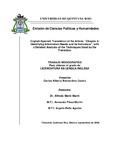Mostrar el registro sencillo del ítem
English-Spanish translation of the article: "Chapter 4: Identifying information needs and its indicators", with a detailed analysis of the techniques used by the translator.
| dc.contributor.author | Bernardino Castro, Carlos Alberto | |
| dc.contributor.other | PEREZ MORFIN, ARMANDO;*CA1342409 | |
| dc.contributor.other | PEÑA AGUILAR, ARGELIA; 466646 | |
| dc.date.accessioned | 2023-09-21T16:32:08Z | |
| dc.date.available | 2023-09-21T16:32:08Z | |
| dc.date.issued | 2008-09 | |
| dc.identifier.uri | http://hdl.handle.net/20.500.12249/3421 | |
| dc.description.abstract | Who needs a translator? There are misconceptions about translators. Anyone speaking two languages is a potential translator. A native speaker of the source language will understand the source text better and therefore produce a better translation. Certain misconceptions that have commonly plagued editors in search of translators should be removed by now. It is not acceptable in the professional field that anyone translating into a language that is not his or her own is able to produce acceptable translations. A translator is one whose native or dominant language is the target language, who has attained a high degree of mastery in the source language, and who has undergone professional training in the translation techniques. I had a friend majoring in a Trading Systems Major, one of the Majors offered at the University of Quintana Roo. He asked me if I could translate twelve pages from English into Spanish. I agreed to do the work. First, I thought there were not difficulties in translating the topic into Spanish. Second, I did not make a previous check about the topic; therefore, I did not know what I was dealing with. My friend told me that I had fifteen days to carry out the translation. I told him not to worry and asked him why he had been given this kind of information in English. He answered me that their teacher had told all the students that they should be able to read in English in the third year of College. | |
| dc.description.provenance | Submitted by Guadalupe Castillo Villanueva (castillogm@uqroo.edu.mx) on 2023-09-21T16:31:23Z No. of bitstreams: 1 PE1128.B47.2008-59552.pdf: 274337 bytes, checksum: dbafaffc8e071039d1650ed2d7860e0b (MD5) | |
| dc.description.provenance | Approved for entry into archive by Guadalupe Castillo Villanueva (castillogm@uqroo.edu.mx) on 2023-09-21T16:32:08Z (GMT) No. of bitstreams: 1 PE1128.B47.2008-59552.pdf: 274337 bytes, checksum: dbafaffc8e071039d1650ed2d7860e0b (MD5) | |
| dc.description.provenance | Made available in DSpace on 2023-09-21T16:32:08Z (GMT). No. of bitstreams: 1 PE1128.B47.2008-59552.pdf: 274337 bytes, checksum: dbafaffc8e071039d1650ed2d7860e0b (MD5) Previous issue date: 2008-09 | |
| dc.format | ||
| dc.language.iso | eng | |
| dc.publisher | Universidad de Quintana Roo | |
| dc.rights.uri | http://creativecommons.org/licenses/by-nc-nd/4.0 | |
| dc.subject | Inglés —Estudio y enseñanza | |
| dc.subject.classification | HUMANIDADES Y CIENCIAS DE LA CONDUCTA::LINGÜÍSTICA::LINGÜÍSTICA APLICADA::TRADUCCIÓN | |
| dc.title | English-Spanish translation of the article: "Chapter 4: Identifying information needs and its indicators", with a detailed analysis of the techniques used by the translator. | |
| dc.type | Trabajo de grado, licenciatura | |
| dc.type.conacyt | bachelorDegreeWork | |
| dc.description.enky | 788 | |
| dc.rights.acces | openAccess | |
| dc.identifier.lcc | PE1128 | |
| dc.identificator | 4||57||5701||570112 | |
| dc.audience | generalPublic | |
| dc.division | Campus Chetumal Bahía | |
| dc.division.sub | División de Ciencias Políticas y Humanidades | |
| dc.division.programa | Lengua Inglesa |
Ficheros en el ítem
Este ítem aparece en la(s) siguiente(s) colección(ones)
-
Licenciatura [2786]





